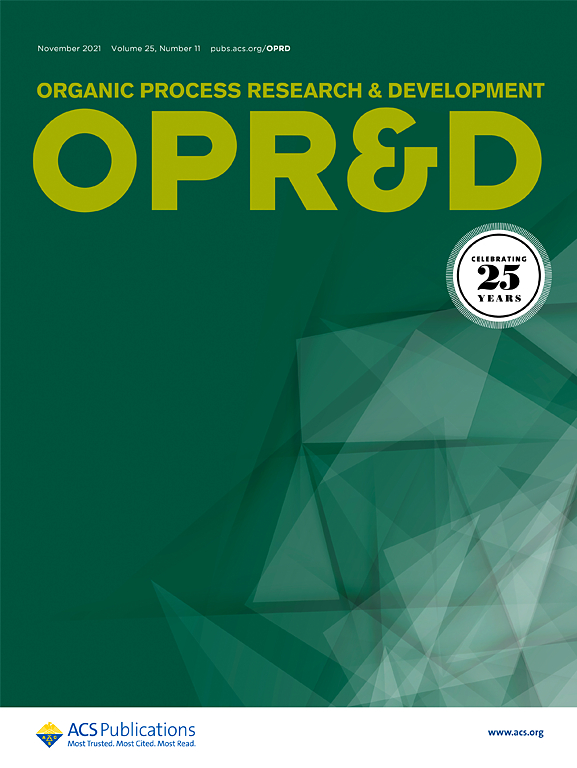Industrial Case Studies Demonstrating Applicability of ICH M7 Control Options 3 and 4 for Nitrosamine Control
IF 3.1
3区 化学
Q2 CHEMISTRY, APPLIED
引用次数: 0
Abstract
The assessment and control of potential mutagenic impurities (PMIs) within pharmaceutical products are managed in accordance with the ICH M7 guideline “Assessment and control of DNA reactive (mutagenic) impurities in pharmaceuticals to limit potential carcinogenic risk”. This guidance highlights four control options that can be used to give assurance of control of PMIs to below a level of toxicological concern for the intended use. These control options range from testing to confirm that impurity levels within the active pharmaceutical ingredient or product are below an acceptable limit (ICH M7 Option 1 Control) to a control strategy that relies on process controls and scientific principles (e.g., purging) to demonstrate impurity presence to below a level of concern in lieu of analytical testing (option 4). While ICH M7 control option 4 is an established approach to justify that levels of a potential mutagenic impurity are below an acceptable limit, there have been health authority challenges that the use of ICH M7 control option 4 rationales is not appropriate for N-nitrosamines without included confirmatory analytical testing data to confirm absence. The reasons behind this lack of acceptance for ICH M7 control option 4 alone may include (i) a higher perceived potency for nitrosamines over other mutagenic impurities as they alert as part of the cohort of concern and (ii) inappropriate application of purge rationales such that, in some instances, confirmatory testing data highlighted higher levels for the impurity than had been predicted to be present. Through the inclusion of industry relevant case studies, this publication outlines that, while some nitrosamines may require control to lower levels than the ICH M7 threshold of toxicological concern, the concept of the ICH M7 option 4 control is scientifically justified when the properties for the nitrosamine are considered and an appropriate conservative purge rationale is applied.

工业案例研究证明ICH M7控制选项3和4对亚硝胺控制的适用性
药品中潜在致突变杂质(PMIs)的评估和控制是根据 ICH M7 指导原则 "评估和控制药品中 DNA 活性(致突变)杂质以限制潜在致癌风险 "进行管理的。该指南强调了四种控制方案,可用于确保将 PMIs 控制在预定用途的毒理学关注水平以下。这些控制方案包括通过检测确认活性药物成分或产品中的杂质含量低于可接受的限度(ICH M7 方案 1 控制),以及依靠工艺控制和科学原理(如净化)来证明杂质含量低于关注水平的控制策略,以代替分析检测(方案 4)。虽然 ICH M7 控制选项 4 是证明潜在致突变杂质水平低于可接受限值的既定方法,但有卫生当局提出质疑,认为在没有包含确认不存在的确证分析测试数据的情况下,使用 ICH M7 控制选项 4 的理由不适合亚硝胺类化合物。仅 ICH M7 控制选项 4 不被接受的原因可能包括:(i) 亚硝胺的效力高于其他致突变杂质,因为它们是受关注群组的一部分;(ii) 不适当地应用清除原理,例如,在某些情况下,确认测试数据显示杂质含量高于预测含量。通过纳入行业相关案例研究,本出版物概述了虽然某些亚硝胺可能需要控制在低于 ICH M7 毒理学关注阈值的水平,但如果考虑到亚硝胺的特性并采用适当的保守净化原理,ICH M7 选项 4 控制的概念是科学合理的。
本文章由计算机程序翻译,如有差异,请以英文原文为准。
求助全文
约1分钟内获得全文
求助全文
来源期刊
CiteScore
6.90
自引率
14.70%
发文量
251
审稿时长
2 months
期刊介绍:
The journal Organic Process Research & Development serves as a communication tool between industrial chemists and chemists working in universities and research institutes. As such, it reports original work from the broad field of industrial process chemistry but also presents academic results that are relevant, or potentially relevant, to industrial applications. Process chemistry is the science that enables the safe, environmentally benign and ultimately economical manufacturing of organic compounds that are required in larger amounts to help address the needs of society. Consequently, the Journal encompasses every aspect of organic chemistry, including all aspects of catalysis, synthetic methodology development and synthetic strategy exploration, but also includes aspects from analytical and solid-state chemistry and chemical engineering, such as work-up tools,process safety, or flow-chemistry. The goal of development and optimization of chemical reactions and processes is their transfer to a larger scale; original work describing such studies and the actual implementation on scale is highly relevant to the journal. However, studies on new developments from either industry, research institutes or academia that have not yet been demonstrated on scale, but where an industrial utility can be expected and where the study has addressed important prerequisites for a scale-up and has given confidence into the reliability and practicality of the chemistry, also serve the mission of OPR&D as a communication tool between the different contributors to the field.

 求助内容:
求助内容: 应助结果提醒方式:
应助结果提醒方式:


